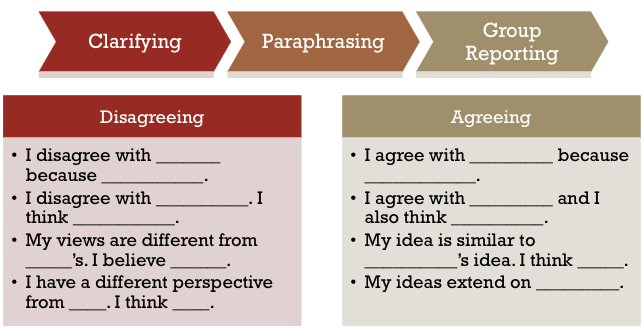We all want our students to be respectful of each other, of us (their teacher) and of their learning. We also want our students to understand and appreciate the viewpoints of others and to appreciate what they are learning and why they are learning it.
So how do we get there?
We use the power of student discourse. Students love to talk, they do it all the time. They are naturally social beings. Our job is to tap into their social nature and give them opportunities to use that skill to learn.
Academic discourse is not innate. We need to provide our student with the tools to effectively communicate with each other academically and in a respectful way. If we don’t, they will dictate the direction of the conversation.
Here are three key components to engaging your students in respectful academic discourse:
- Provide students with meaningful opportunities to engage with each other in relevant conversations about what they are learning and how they know they are learning it on a daily basis. Create opportunities for them to talk in a variety of ways: whole group, small group or pairs. Be sure that all students have equal opportunity to engage in these conversations.
- Listen, yes… Listen to what students are talking about.To do this you must be actively involved and dipping in to their conversations as they happen. Stop, engage with the students by repeating what you are hearing – this is not a time to take a break!
Repeating what students say in partners or groups shows students:
-
- That you care about what they are saying
- That you are validating what they said
- That you are willing to hold them accountable for what was discussed.
It is also a great opportunity for you to support students that are struggling by modeling questioning and thinking strategies to scaffold the process.
- Provide structures for students to engage in meaningful conversations:
Here are 3 structures to try…
-
- Provide a list of sentence stems to get the conversation started and response stems they can use to practice questioning and active listening skills. Students will become more confident in sharing their thinking, asking questions and presenting information in front of the class once they are familiar with how to effectively use these conversation starters.

- Use the Partner Oral Fluency strategy to get students processing, organizing and integrating information. Students take turns summarizing a reading selection of text and then check for understanding with their partner during a structured time frame. This process can be used with the reverse Jigsaw strategy where students become the expert of a section of text and report back to the group a summary of its main points.
- Reverse Jigsaw: This is an effective strategy to use when working with longer readings such as a chapter review in Science or reviewing the first 5 chapters of a novel study. Choose 5 sections of text: create groups of 5 students, all the 1’s, 2’s, 3’s, 4’s, and 5’s get together and use partner oral fluency to summarize text as a group, then return to their original group of 5 and share out their section in order. As a group they summarize the text as a whole.
- Provide a list of sentence stems to get the conversation started and response stems they can use to practice questioning and active listening skills. Students will become more confident in sharing their thinking, asking questions and presenting information in front of the class once they are familiar with how to effectively use these conversation starters.
When we tap into students’ social nature, give them tools to converse academically and provide opportunities for students to utilize new discourse strategies, an amazing thing happens… They engage in their learning; they talk about what they are learning more and less about what they are doing on the weekend. In addition, students learn to understand and appreciate the viewpoints of others and to appreciate what they are learning and why they are learning it.
